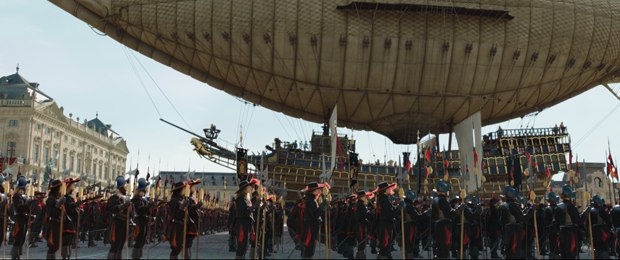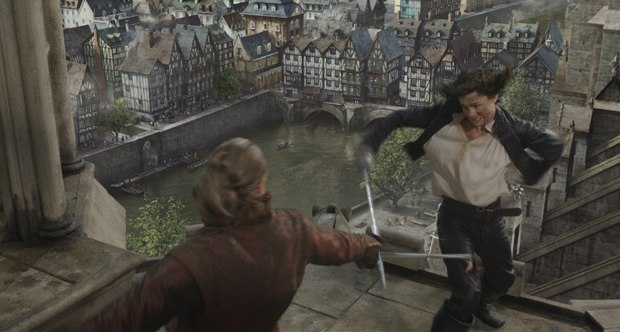Read about Mr. X's VFX challenges with the latest 3-D reboot of Alexandre Dumas' classic adventure.
That's right: one look at those cool airships and you can tell that Resident Evil's Paul W.S. Anderson has gone steampunk with The Three Musketeers. This was fine by VFX production supervisor Dennis Berardi and his Mr. X, which definitely raised their game.
"The main challenges were to create the illusion that we were in Paris and London and Venice of the era when we actually shot in Germany," remarks Berardi. "And Paul Anderson wanted scope and to bring all of his action sensibilities to this rendition of The Three Musketeers. But we have these airships that are the warships of the day and whoever builds them holds the balance of power. And so they play prominently in the film. And there's a huge airship battle over Paris that is reminiscent of Master and Commander. There are 275 shots in total, which doesn't sound like a lot, but we had very long shots, and each one is so complicated that it seemed like 10 shots. We had shots with 14,000 cardinal guards; we had shots with full-CG, full-frame airships; we had digital doubles; full hero environments that were photorealistic; and it was all shot in stereo on the Arri Alexa cameras with the Pace rigs."
Using a combination of partial practical set pieces with CG set extensions and fully CG built ships, Mr. X created the enormous flying vessels. However, due to the shooting style and how tight they came into the airships, cheating out the look was not an option. To believably seam the practical with the CG and create the full CG airships, they had to individually model, animate, light and render every single bolt, rivet, pulley, rope and sail, so it would all work cohesively together. Paying such intricate attention to the airship's details, though, provided complete control over the lighting and allowed for a very natural use of interaction between elements.
In fact, the complexity of the ships' designs along with the sheer amount of detail made for intensely large working files. Thus, the Mr. X team of pipeline developers led by CTO Jim Price developed and wrote a set of custom tools that would help manage the sheer volume of information. And for this film they had to introduce a new cloth sim dept, and refine their VRAY pipeline to accommodate such unique needs.
"We built the Cardinal's airship, which included cloth simulations for the sails and dynamic simulations for the balloon itself," Berardi continues. "The rigging was all simulated with real world physics; and the same with Buckingham's airship, which was entirely different. Then we had to do various stages of damage for each of those ships as they do battle. The Cardinal's ship actually crashes into Notre Dame and gets spiked by the spire. And for the very last shot of the film, we built variations of Buckingham's airship as a fleet."
Mr. X employs a Houdini/Maya pipeline, and so their VFX department created debris, destruction, clouds, storms, water, mist and fog. This meant that their artists relied heavily on the Houdini-based programmers to build custom tools for specific shot requirements. To allow fire simulations to be worked on in real time, for instance, they built their own GPU-based fire tool and also implemented a custom bullet physics solver that provides near real time destruction simulations. Numerous Houdini simulations for debris and destruction were baked out in VRAY proxy format so that they could be rendered out at the same time as the hero assets such as Notre Dame and the destruction of airships. This process allowed for lighting, shadow and reflection interaction within the same scene that would be substantially more difficult in a traditional separate pass pipeline.
Mr. X was also responsible for creating massive digital armies, populating ship decks and creating hero digital doubles. This represents a milestone for the company. To accomplish this required upping the VRAY shading pipline to a new level by re-writing the base shaders and providing the look-dev artists with a comprehensive library of such base materials as leather, silk, linen as well as new skin and scatter materials. All of the template shaders were written to be in balance in a digital recreation of the on-set light stage, character acquisition and lighting environments. Mari was introduced for the first time to handle the sheer volume of textures and extremely intricate details.
"It was mostly daylight exteriors for these airships so it was not very forgiving," Berardi adds. "So we tried to use an image-based lighting model where possible, which helped us. In the end, I think we achieved photorealism; however, the film does have a slightly stylized look. That played in our favor and helped overall in creating the illusion that we were in the 17th century."
Bill Desowitz is former senior editor of AWN and editor of VFXWorld. He has a new blog, Immersed in Movies (www.billdesowitz.com), and is currently writing a book about the evolution of James Bond from Connery to Craig, scheduled for publication next year, which is the 50th anniversary of the franchise.












